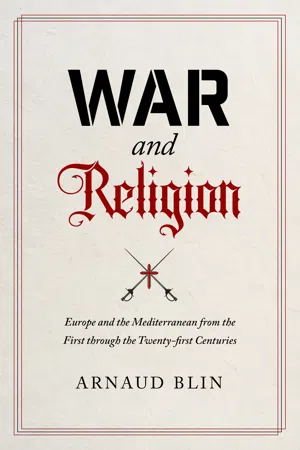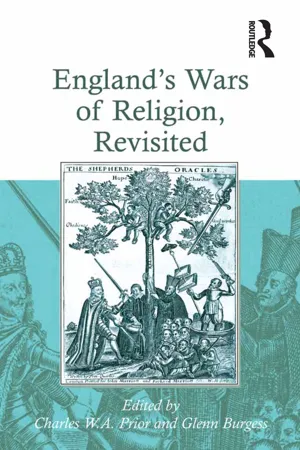History
Wars of Religion
The Wars of Religion were a series of conflicts in Europe during the 16th and 17th centuries, primarily between Catholics and Protestants. These wars were fueled by religious and political tensions, leading to widespread violence and upheaval across the continent. The Peace of Westphalia in 1648 marked the end of the major religious wars and established the principle of state sovereignty in international relations.
Written by Perlego with AI-assistance
Related key terms
3 Key excerpts on "Wars of Religion"
- eBook - ePub
The Struggle for Power in Early Modern Europe
Religious Conflict, Dynastic Empires, and International Change
- Daniel Nexon(Author)
- 2009(Publication Date)
- Princeton University Press(Publisher)
CHAPTER 7The French Wars of Religion
THE FRENCH WARS OF RELIGION (1562–1629) provide more evidence for how the spread of heterodox religious movements exacerbated underlying dynamics of resistance and rule in early modern European states. Historians typically divide the French Wars of Religion into nine different conflicts, beginning in 1562 and ending in 1598 with the promulgation of the Edict of Nantes. But the Edict of Nantes did not end religious warfare within the country; Mack P. Holt, therefore, extends the history of the French Wars of Religion until 1629 and the Peace of Alais (June 1629).1 The political history of overt Protestantism in France continues beyond that, until Louis XIV revoked the Edict of Nantes in 1685.2These conflicts deserve our attention for a number of reasons. First, they profoundly shaped early modern European politics. They destroyed, for decades, the ability of France to operate as a great power. They also intersected in a number of crucial ways, as we have already seen, with the Dutch Revolt and the practice of Spanish hegemony. Thus, the French Wars of Religion provide a stark reminder of the significant political implications of “transnational” religious movements. Second, the conflicts provide additional evidence for the importance of those mechanisms and processes elaborated in this book. Historians have a long tradition of debating the “political” or “religious” character of the civil wars that dominated France in the second half of the sixteenth century. This distinction, which parallels realist and constructivist debates in international-relations theory, no more helps us to understand the French Wars of Religion than it does the Dutch Revolt or the Schmalkaldic War. As Julien Coudy notes, “politics and religion” in the French Wars of Religion “were inextricably intermingled and matched together.”3 - eBook - ePub
War and Religion
Europe and the Mediterranean from the First through the Twenty-first Centuries
- Arnaud Blin(Author)
- 2019(Publication Date)
- University of California Press(Publisher)
30 Aided by the duc de Sully, a former Huguenot soldier, Henri IV had managed before his death to steer his country back in the right direction. France, the most powerful country in Europe, led the way into the age of absolutism, and the European monarchies that came to embody this period had one primary objective in mind: to avoid unrest and instability that might jeopardize their hold on power. For all of the sovereigns of Europe, great and small, it was clear that confessional conflicts were to be avoided at all costs. The French Wars of Religion were not, however, the last of the “wars of opinion,” as they came to be called. Another, much more deadly, conflict was soon to engulf the greater part of Europe. It came to be known as the Thirty Years’ War.THE WAR TO END ALL RELIGIOUS WARS
The Thirty Years’ War is generally considered by historians to be the most deadly conflict to have been fought before World War I and World War II, though this can be disputed. Even in the subcategory of religious conflicts, it is probably surpassed by the Taiping rebellion in the nineteenth century, in which twenty to one hundred million people died. Nevertheless, it was, as Pierre Chaunu says, “a catastrophe without equivalent.”31However much one would like to come up with reliable or even approximate casualty figures, the statistics are too fragmented to allow for it.32 Demographic comparisons, however, give us an idea of the damage: the population of the Holy Roman Empire, estimated at twenty million at the turn of the seventeenth century, fell to about seven million in 1650 (it was back to twenty million a century later, in 1750).33 In Pomerania and Mecklenburg in northern Germany, 65 percent of the population died as a result of the war. More reliable city registries show dramatic numbers: in Frankfurt an der Oder, the population fell from 13,000 to just 2,400 between 1618 and 1654.34 In the Czech lands, Bohemia and Moravia, the population plunged from two and a half million inhabitants before the war to a little over one and a half million at the end of the conflict.35 - eBook - ePub
- Glenn Burgess, Charles W. A. Prior(Authors)
- 2016(Publication Date)
- Routledge(Publisher)
2. How does the ‘war of religion’ hypothesis help us to understand the patterns of Civil War polemic, in particular the pattern of Royalist polemic? 3. How do retrospective historical accounts of the 1640s (from the Royalist perspective) map on to the understanding of the English Revolution as a religious war?I. Conceptual Frameworks
Early modern historians have spent considerable time in discussing what they might mean by the idea of a ‘war of religion’, and it was, of course, part of the force of John Morrill’s application of the label to the English Revolution that these events should be understood as falling under a distinctively early modern category, locating the English Revolution in a post-Reformation rather than a proto-modern historical period, and thus making some claim about the sort of long-term narratives in which it ought to figure. That latter claim was powerfully developed in parallel work by Jonathan Clark, challenging more overtly the modernising, revolutionary meta-narratives of Whig history. In much current European historiography the idea of a ‘war of religion’ is integral to the ‘confessionalisation’ model of post-Reformation historical change, identified most strongly with Heinz Schilling; and some of the application of the concepts ‘war of religion’ and ‘confessional state’ to the English case are more or less conscious offshoots of this historiography.1This chapter will side-step the task of constructing an analytical model of a ‘war of religion’, against which to measure the various events competing for the label. Instead, I want to ask a different, though not unrelated question, namely what concepts English (or European) people in about 1640 had that could map on to what we might call a ‘war of religion’. And in answering this question, I will try to depend less on theoretical accounts of just war or holy war, and more on the application of assumptions and concepts to particular cases.
Learn about this page
Index pages curate the most relevant extracts from our library of academic textbooks. They’ve been created using an in-house natural language model (NLM), each adding context and meaning to key research topics.


